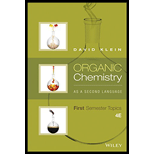
Concept explainers
Interpretation:
The more acidic compound has to be predicted among the given pair of compound.
Concept Introduction:
Acids donate protons, base accepts protons. The strength of the acid can be said by finding the willingness of the acid to give proton. An acid giving away the proton can be represented in the form of equation as shown below,
If the acid “HA” is very much willing to give the proton it holds means then it is known as a strong acid. If it is not very much willing means it is a weak acid. The strength of the acid can be figured out by looking into the conjugate base that is formed on removal of proton. After loss of proton, a negative charge will be created. If the formed negative charge is more stabilized means then the acid is a strong acid and if it is not stabilized means then it is a weak acid.
There are few factors which determine the strength of the acid and they are,
- What atom the charge is present
- Resonance
- Induction
- Orbitals
If the charge is on a more electronegative atom, then it is stabilized more. Hence, the compound will be more acidic.
If the negative charge is made to participate in resonance, then the negative charge will be stabilized. This increases the stability of the conjugate base and in turn the compound will be more acidic.
Pull of the electron density by the more electronegative atom is known as induction. The inductive effects can stabilize or destabilize the conjugate base. If the inductive effect stabilize the conjugate base, then the compound will be acidic.
The orbital in which the negative charge is present also plays an important role in stability of the conjugate base. A negative charge on
In order to find whether the compound is more acidic or not, the first step is to remove the proton to form conjugate base. Then look for the above four factors.
Want to see the full answer?
Check out a sample textbook solution
Chapter 3 Solutions
Organic Chemistry As a Second Language: First Semester Topics
- Which region(s) of the following phospholipid is/are hydrophobic? RO I hydro-water phobic-dislikes = Hydrophobic dislikes water ○ I only Il only I and III only II and IV only O II, III, and IV only III || IVarrow_forwardPredict the product of the following reactions: O 0= excess Х Кон ОН H+ H+ Iarrow_forwardHow many chiral centers/stereocenters are there in the following molecule? 1 2 3 4arrow_forward
- Which of these correspond to the molecule: 2,5-dimethylheptanearrow_forwardGiven the following data, determine the order of the reaction with respect to H2. H2(g) + 21Cl(g) → I2(g) + 2HCl(g) Experiment [H2] (torr) [ICI] (torr) Rate (M/s) 1 250 325 0.266 2 250 81 0.0665 3 50 325 0.266arrow_forwardWhich one of the following molecules is chiral? H- NH₂ H3C དང་།་ OH H HO H₂N HO- -H CHO -OH H HO- OH H- -H CH₂OH OHarrow_forward
 ChemistryChemistryISBN:9781305957404Author:Steven S. Zumdahl, Susan A. Zumdahl, Donald J. DeCostePublisher:Cengage Learning
ChemistryChemistryISBN:9781305957404Author:Steven S. Zumdahl, Susan A. Zumdahl, Donald J. DeCostePublisher:Cengage Learning ChemistryChemistryISBN:9781259911156Author:Raymond Chang Dr., Jason Overby ProfessorPublisher:McGraw-Hill Education
ChemistryChemistryISBN:9781259911156Author:Raymond Chang Dr., Jason Overby ProfessorPublisher:McGraw-Hill Education Principles of Instrumental AnalysisChemistryISBN:9781305577213Author:Douglas A. Skoog, F. James Holler, Stanley R. CrouchPublisher:Cengage Learning
Principles of Instrumental AnalysisChemistryISBN:9781305577213Author:Douglas A. Skoog, F. James Holler, Stanley R. CrouchPublisher:Cengage Learning Organic ChemistryChemistryISBN:9780078021558Author:Janice Gorzynski Smith Dr.Publisher:McGraw-Hill Education
Organic ChemistryChemistryISBN:9780078021558Author:Janice Gorzynski Smith Dr.Publisher:McGraw-Hill Education Chemistry: Principles and ReactionsChemistryISBN:9781305079373Author:William L. Masterton, Cecile N. HurleyPublisher:Cengage Learning
Chemistry: Principles and ReactionsChemistryISBN:9781305079373Author:William L. Masterton, Cecile N. HurleyPublisher:Cengage Learning Elementary Principles of Chemical Processes, Bind...ChemistryISBN:9781118431221Author:Richard M. Felder, Ronald W. Rousseau, Lisa G. BullardPublisher:WILEY
Elementary Principles of Chemical Processes, Bind...ChemistryISBN:9781118431221Author:Richard M. Felder, Ronald W. Rousseau, Lisa G. BullardPublisher:WILEY





